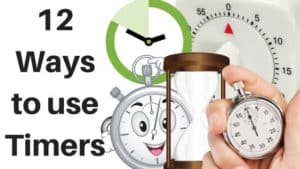Using Timers = Reducing Anxiety = Improved Behaviour
I often find your best strategies come when you reflect on yourself and try to put yourself in a child with an ASD’s shoes. Think how you use time, when it goes fast, when it drags, when it helps you plan, when it makes you anxious, when do you look at the time constantly. Have you ever lost your watch, how did it feel? Now let’s think of a child with an ASD and look at how they are using time.
Timers can support students who have difficulty with executive functioning by helping them with self-monitoring, time management, prioritising, organisation, planning and impulse control (waiting).
Time Timers and Portable Schedules with Digital Timers are a MUST for all children on the autism spectrum. These are invaluable at both home and school.
Time Timers are specifically designed for use by those with an autism spectrum disorder. The notion of ‘time’ can be very difficult to understand for these children – particularly in the younger years. With a graphic visual of time passing, children can have a better understanding of time. The Time Timer is a great product which reinforces the sense of elapsed time with a graphic depiction of the time remaining.
For children who can recognise numerals you can also use digital timers. The Portable Schedule with Digital Timer can link visual schedules with a time frame. You can set the timer to count up or count down time.
Liquid Timers are an incredibly useful tool. You can use them as a calming tool, a reward, to teach children to wait, to give them time to process or to refocus them when transitioning to new activities.
12 Helpful Ways to Use Timers
- Daily Schedule: Ensure your schedule has time, so students know how long they are doing each activity.
- Assembly: Create a schedule of what is happening: Singing, Dance, Listening, etc. Knowing HOW long they need to sit can sometimes help them sit for longer, rather than not being able to see an end point.
- Change in Timetable: School and home often have changes, using timers can show how long and when activities will happen.
- Naplan/Exams: Help the student know how much time to spend on each question, start and finish times.
- Home: Break homework into small achievable time slots. 10 minutes work, 20 minutes play, etc.
- Toilet and Drink: Use the timer to create one hour drink and toilet breaks.
- Anxiety: Create regular times for the student to have a break and relax. 10 minutes doing a favourite activity can stop a meltdown. For children who have separation anxiety, knowing how long a parent is staying and when they will return is a great way to reduce stress. It is important to be consistent with time if you use this strategy.
- Technology/Special Interests: Many children lose track of time when they are doing something they love, by using a timer it pre-warns them when they need to finish. Many activities they love do not have an end point or they want to repeat the activity. Timers create a finish point.
- Reward: When you reward a child ensure they do not spend too long on their “interest”, have a set time to do the activity. (See pg 9 Using Rewards).
- Breaks Times: Many children have difficulty transitioning from inside to outside, pre-warning them when the change is going to happen prepares them.
- Waiting: Use timers to help children know how long they have to wait for a turn, how long until they need to wait to do a preferred activity, etc.
- Calming: Use the liquid timers for calming or stress release for the child. Often the slow dripping of the liquid or spinning of the wheels inside.




 Sorry we no longer ship items outside Australia. Please consider the digital versions of Sue’s Books –
Sorry we no longer ship items outside Australia. Please consider the digital versions of Sue’s Books – 